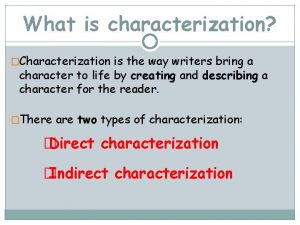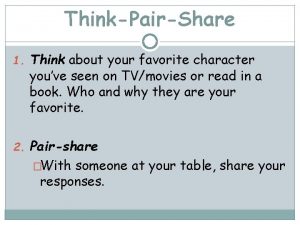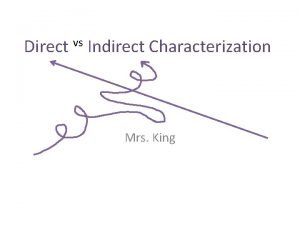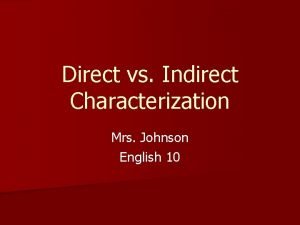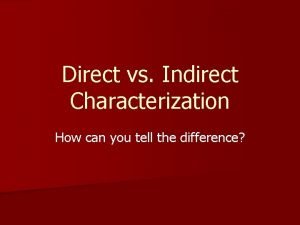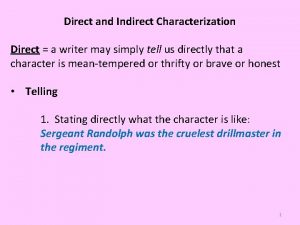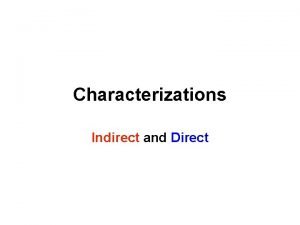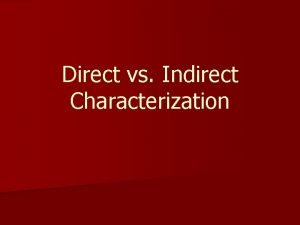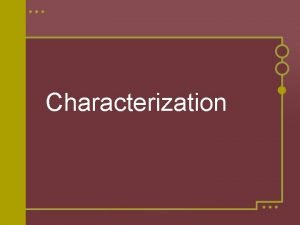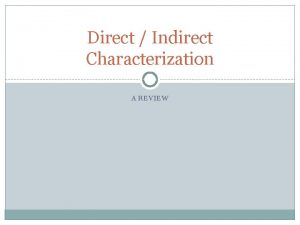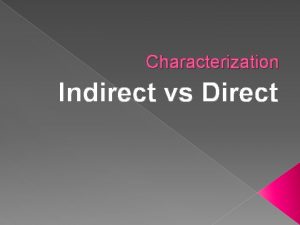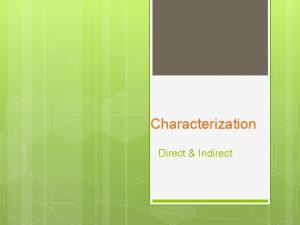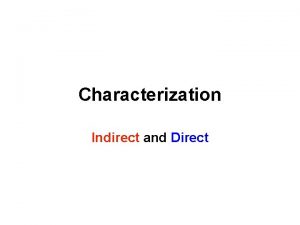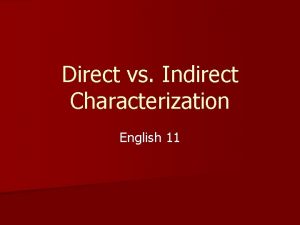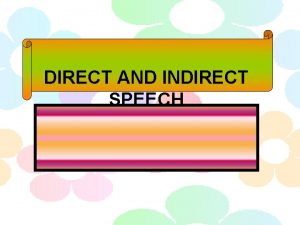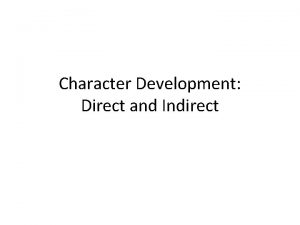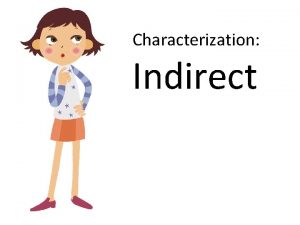Character Analysis Direct vs Indirect Characterization Direct Characterization














- Slides: 14

Character Analysis

Direct vs. Indirect Characterization Direct Characterization: the writer makes direct statements about a character’s personality and tells what the character is like. Example: “The patient boy and quiet girl were both well mannered and did not disobey their mother. ”

Direct vs. Indirect Characterization: the writer reveals information about a character and his or her personality through that character’s thoughts, words, and actions, along with how other characters respond to that character, including what they think or say about him or her. STEAL: Speech, thoughts, effect on others, actions, looks. https: //www. youtube. com/watch? v=tmzg 4 Ko. Ps. Ug

S. T. E. A. L. https: //www. youtube. com/watch? v=tmzg 4 Ko. Ps. Ug Write short responses to the five different methods of indirect characterization. Speech: What does the character say? How does the character speak? Thoughts: What is revealed through the characters private thoughts and feelings? Effect on others toward the character: What is revealed through the character’s private thoughts and feelings? Actions: What does the character do? How does the character behave? Looks: What does the character look like? How does the character dress?

Protagonist The most important or leading character; usually the hero or heroine, but not always.

Antagonist The character pitted against the protagonist. An evil or cruel antagonist is a villain but the antagonist is not always a villain.

Round Characters Fully developed like real people with fullblown personalities.

Flat Characters Two dimensional, relatively uncomplicated and do not change throughout the course of a work.

Round/Flat Let's begin by thinking about round and flat characterization like a painting. If you are an artist, you must decide how much detail to put into a painting. Do you want many lines and many colors or just an outline and only black and white?

Static Characters Do not change significantly during the course of a work.

Dynamic Characters Do change (for better or worse) in response to circumstances

Character Profile a Assignment 10 points Must include comments along with profile pictures based on Myers direct and indirect characterization. Can work with a partner or small groups, but if one character comments to another, then all other papers must reflect the same comment and profile picture Pictures should be in full color full credit The comments and info need to show an understanding of the character from the text Quotes and conversations can either be direct quotes and conversations from the text OR made up, text-talk and modern abbreviations – must be appropriate

Characters Scout Jem Atticus Calpurnia Dill Boo Radley Miss Maudie Atkinson Mr. & Mrs. Radley Miss Stephanie Crawford Mr. Nathan Radley

Character Analysis Assignment EXAMPLE: 1. The Boss Quality – organized, suspicious, assertive Flat Character Textual proof: “He pulled his time book out of his pocket and opened it where a pencil was struck between the leaves… The boss licked his pencil” (Steinbeck 21). Explanation: The boss has just arrived and met Lennie and George. He is checking on his new men. Here he enters their names into his book. He makes sure that he writes down exactly what time the men will start working. He listens to why they have missed their ride to the field. He keeps track of who is working for him and when in his book. These actions show that he is an organized man as he has record of who is working for him and when.
 Direct characterization
Direct characterization Direct indirect characterization
Direct indirect characterization What is characterazation
What is characterazation Direct and indirect characterization
Direct and indirect characterization Direct vs indirect characterization
Direct vs indirect characterization Define direct characterization
Define direct characterization Characterization examples
Characterization examples Direct and indirect characterization
Direct and indirect characterization Direct and indirect characterization worksheet
Direct and indirect characterization worksheet Characterization
Characterization Indirect characterizations
Indirect characterizations Direct and indirect characterization
Direct and indirect characterization Indirect and direct characterization
Indirect and direct characterization Indirect vs direct characterization
Indirect vs direct characterization What is the definition of characterization
What is the definition of characterization


